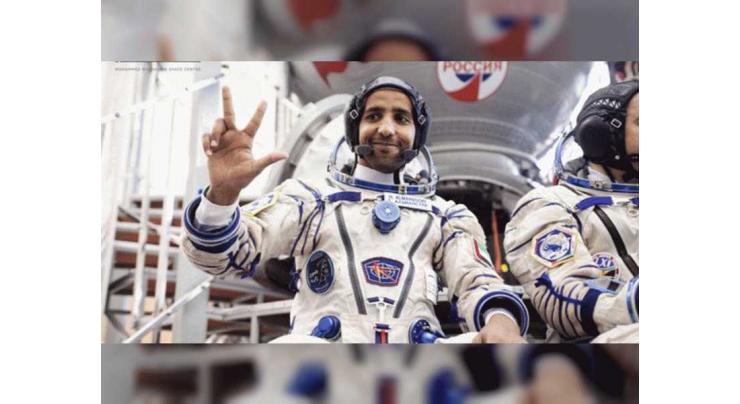
Students Engage With Hazza Al Mansoori To Control Int-Ball Aboard ISS
Umer Jamshaid Published September 30, 2019 | 09:00 PM

DUBAI, (UrduPoint / Pakistan Point News / WAM - 30th Sep, 2019) On his fifth day aboard the International Space Station, Emirati astronaut Hazza Al Mansoori started his day by communicating with the Mohammed bin Rashid Space Centre, MBRSC, teams at the ground stations in Moscow and in Dubai and informing them of his daily schedule.
Communicating with the ground station in Dubai, MBRSC organised two video conference calls between Al Mansoori, school students, and the public.
The first conference call was held in cooperation with the Japan Aerospace Exploration Agency, where Al Mansoori showed how the JEM Camera Robot, Int-Ball, works aboard the ISS. Students were given the opportunity to interact with Al Mansoori to select the correct answers to control the Int-Ball.
The conference call was also attended by Emirati students in Japan, in the presence of Khaled Omran Al Ameri, UAE Ambassador to Japan, and a team from MBRSC.
The second conference call was held in cooperation with the Russian Space Agency Roscosmos, where students asked Al Mansoori how water reaches the ISS, what is the most beautiful thing at the station, how he sleeps, why astronauts are trained at hyper-gravity, reaching 9G’s, what changed in his body during this trip, and if he has visited the different divisions and sections at the station.
In his answer, Al Mansoori explained that water is delivered to the station via cargo, which are similar to the Soyuz spacecraft that carry astronauts to the ISS.
He added that the steam is collected from the station and converted to water."The most beautiful thing in the station is microgravity; watch how ‘Suhail’ – the mission mascot– is floating, and watch how I drink water," said Al Mansoori. He highlighted that astronauts train at a gravitational force of 9-G prior to traveling to space because the gravitational force in the rocket reaches 5-G during launch, and can reach 9-G at emergency situations.
"I visited all the departments at the ISS, in a tour where I filmed everything. Today I was at JAXA’s Kibo Laboratory, and yesterday I was at ESA’s Columbus Laboratory. I'm excited to share with you the first video about the station in Arabic soon," added Al Mansoori.
"Many changes happened in my body, the size of my head grew bigger because of the rush of fluids upward, and my sense of smell also changed. However, I began to adapt and get used to it after some time," continued Al Mansoori. Checking his health status Al Mansoori also spoke to Dr. Hanan Al Suwaidi, the flight surgeon for the mission, who is following his medical status throughout his time in space.
Al Mansoori also trained on the descending procedure on the Soyuz MS-12, along with Nick Hague and Aleksey Ovchinin.
Al Mansoori conducted a study on the autonomic regulation of cardiovascular system, central hemodynamic, and the influence of space flight factors on the spatial distribution of the energy of heart contraction. Al Mansoori then began the experiments involving schools in the UAE as part of MBRSC’s Science in Space initiative. Documenting life aboard the ISS, Al Mansoori recorded his diary for 15 minutes to document life aboard the ISS and his activities aboard.
Al Mansoori will conduct 16 scientific experiments in cooperation with international space agencies, including Roscosmos, ESA, NASA, and JAXA. Six of these experiments will be conducted in microgravity, and the results of the two environments will later be compared. The experiments include studying the reaction of vital indicators of the human body aboard the ISS. Al Mansoori be the first astronaut from the Arab region to participate in such research.
Recent Stories

Turkey's Freedom Flotilla ready to set sail for Gaza

French teen dies from heart failure after knife attack near school

Iranians appear unfazed by Isfahan blasts

UAF celebrates Int'l Chinese Language Day

Mirpur Police arrest 68 suspects of food outlet attack

Ecuador mayor killed ahead of anti-crime referendum: police

Flooding on Chitral-Peshawar Highway strands travelers

Bilawal Bhutto demands govt to hold tripartite dialogue to curb terrorism

Punjab ombudsman facilitates over 1.36 crore payment to victims

Croatia top court bars president from becoming next PM

Leghari seeks KP Govt’s cooperation in anti-power theft campaign

Sehwan Development Authority's staff protests against non-payment of salaries
More Stories From Middle East
-

UAE announces ‘Zero Bureaucracy Program’ to reduce bureaucracy
3 months ago -

COP28 President-Designate welcomes Transitional Committee agreement to operationalise Loss and Damag ..
6 months ago -

Global Media Congress 2023 to feature Co-Production Majlis as a new networking platform
6 months ago -

Young female athletes shine at Abu Dhabi World Youth Jiu-Jitsu Championship
6 months ago -

King of Jordan receives Abdullah bin Zayed and ministers participating in Arab coordination meeting
6 months ago -

Abdullah bin Zayed participates in coordination meeting of Arab foreign ministers, joint meeting wit ..
6 months ago
-

3rd annual conference of Emirates Society of Clinical Microbiology kicks off in Dubai
6 months ago -

SIBF 2023 hosts Nobel laureate to discuss emergence of ‘Afrofuturism’ in global discourse
6 months ago -

ALC announces winners of Kanz Al Jeel Award 2023
6 months ago -

SIBF turns spotlight on remarkable contributions of women
6 months ago -

Global assets in spot bitcoin ETFs hit $4.16 billion
6 months ago -

Rescuers struggle to find Nepal quake survivors as deaths reach 157
6 months ago











